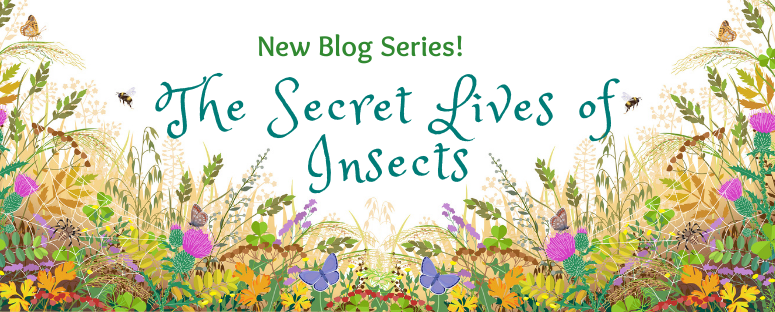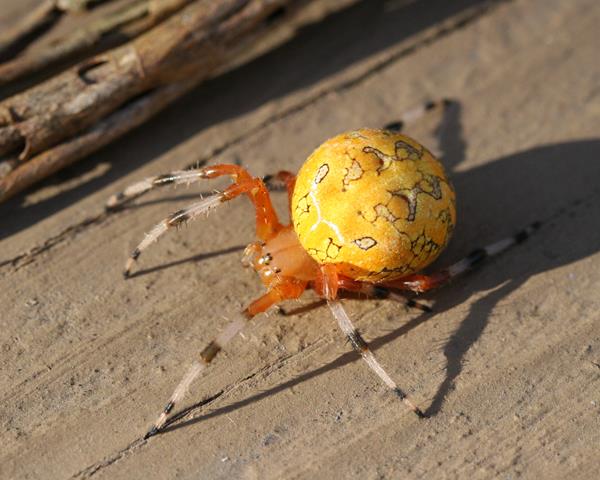
Brace Yourself. 'Arachtober' Is Just Around The Corner!
By Judy Ferris, Master Naturalist & Guest Blogger
Check out the video below to see a Black and Yellow Garden Spider wrapping paralyzed prey. Video by Wildlife Protection Solutions – 1:41
- A spider, by contracting its abdomen, can increase its hydrostatic pressure up to eight times its resting level in order to extend the legs. With a sudden increase in body pressure, some Jumping Spiders can jump up to 50 times their body length .
- Never underestimate the power of hydrostatic pressure! Wolf Spiders can race at a speed up to 2 feet per second. (Iorio 2005)
- A spider’s legs curl up when it dies because there is no fluid to extend them. (Morgan 2011)

- Spiders that chase down their prey have modified the claws into tufts. The ends of the tufts split into as many as 1000 bristles. The tufts get their grip through contacting minutely thin layers of water on surfaces. (Rupert, Fox, and Barnes 2004)
- Spiders cannot get out of bathtubs because the surface is too slippery. Garden Spiders cannot crawl up walls because they have claws rather than bristles.
- Spiders are exclusively carnivores . Clearly, this is bad news for insects, other spiders, small lizards, and assorted tiny creatures.
- Most spiders can digest only liquid food . Thus, prey must be liquefied (pre-digested) before it can be consumed. When prey is captured, the spider first bites its victim to inject paralyzing venom. Digestion begins when the spider spits up a drop of digestive fluid from its intestinal tract and places it upon the hapless prey. After a few moments of marination, the liquid begins to dissolve the prey. The spider simply sucks up the goo. Spit, suck, and repeat until the victim is an empty husk. An arachnid gourmet feast!


- Lacking good vision, spiders have other ways to monitor their surroundings. They can ‘taste’ and even ‘smell’ with their legs, which are equipped with special hairs and sensory organs.
- Spiders ‘hear’ an approaching insect with special vibration-sensing hairs and tiny slits found on much of their legs and body. Vibrations are big in the spider world. A web-building spider, for example, hiding in wait, can distinguish between different types of prey hitting their webs. A bee, a moth and a fly each make a unique vibration when contacting a web.
Watch an Orb Weaver Spider build a web in this gorgeous video from BBC – 4 minutes.
-
- Spiders are able to produce 7 different types of silk, but no one species produces all seven silk varieties.
- A single strand of spider silk long enough to encircle the earth would weigh slightly over a pound. (Twila 2017)
- Spider silk used in webs is five times stronger than the same thickness of a strand of steel.
- A web of spider strands as thick as a pencil could stop a Boeing 747 in flight. (Kelley 2008)
- The Darwin Spider creates giant webs that span rivers and streams. The support strands are 10 times stronger than Kevlar. (Choi 2010)
- Many spiders, including orb weavers such as our common Black and Yellow Garden Spider, eat their webs every night and reuse the same material to build them the next morning.
- Hundreds of years ago, people used spider webs to cover wounds, believing that it would help staunch the bleeding. Today we know that spider silk contains vitamin K, a blood clotting agent.
- Scientists estimate that an average acre of land on planet Earth is home to 1 million spiders. The number may be closer to 3 million in the tropics.
- 45,000 spider species have been identified. Many more species remain undiscovered.
- Spiders are present on every continent except Antarctica and are found in all habitats; snow-capped peaks at 11,000 feet, beneath the surface of water, in caves, deserts, and yes, even in your home!
- It is estimated that at any given time no human on the planet is more than 10 feet from a spider. Ever!

- If you are a spider, peril lurks in every direction.
- Danger can come out of the sky in the form of a bird. Carolina Wrens, for example are particularly fond of spiders and may often be seen patrolling the exterior of your house for tasty spiders.
- Amphibians and reptiles help control spider populations. Lizards in particular are voracious eaters of spiders and can eradicate them in a controlled environment.
-
Some wasp species rely on spiders to serve as hosts for their larvae. Mud dauber wasps prowl insect-rich areas such as your flower garden, specifically in search of spiders. Once a spider is found, the wasp administers a paralyzing sting which renders the spider inert, but not dead, then lays an egg inside the spider’s abdomen. The wasp packs the spider into its larder, adding more spiders until it judges that it’s enough to feed a hungry larva. Then she uses mud to seal the chamber shut and sets to work on the next chamber. The end result is rather like a row of mini-storage warehouses stuffed full of undead arachnids! When the wasp egg hatches, the larva eats the spider from the inside out, feasts on other spiders as needed, pupates, then bursts out of its clay chamber as an adult wasp.
-
Many spider species fully embrace cannibalism, hunting and happily feasting on their spider cousins. Male spiders are generally small and unassuming. In some species the female may consume the male as a snack after mating.
- A typical spider eats about 2,000 insects each year. (Walker 2004)
- In 2012, scientists estimated that worldwide, spiders consumed an estimated 600 million metric tons of insect biomass annually. That is about the same weight as the Great Pyramid of Giza in Egypt. A separate study at about the same time concluded that the weight of all the humans on the planet was a mere 287 million metric tons. Less than half of the biomass eaten by spiders in a single year. Yes, we definitely need spiders on our planet!
- Spiders are a vital link in the food chain, providing nutrition for birds, insects, other spiders, and many other animal species.

Spiders have not survived on earth for 400 million years without being supremely adaptable. In this brief examination of the astonishing world of spiders, we have barely scratched the surface of the wonders and variety in every aspect of the Arachnid family. Next time you see a spider, take a moment to appreciate this essential 8-legged friend who works tirelessly to rid our world (indoors and out) of insect pests. That spider who patrols your house for bugs? It deserves a better reward than a smack with a newspaper. Instead, escort the little critter out to your garden where it can do some good!